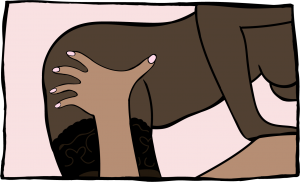lust
Lust (or libido, passion, being horny, being in love) refers to feelings and behaviour that in our evolution have been programmed to lead to sexual intercourse. This relates lust (and its opposites, such as aversion, dislike, disgust, fear, hatred, disapproval, and so on) to the sexual system, reproduction, the distinction between the sexes and the family.
Lust and aversion
It is common knowledge that lust and aversion usually go together. The male has to overcome various obstacles and dangers in order to impregnate as many females as possible. The female defends herself against overly sexual male attention. She wants to attract as many males as possible, but at the same time she has to restrict her choice because she must choose the best possible mate who will also be prepared to help her bring up baby. The dynamics of this sexual interaction is sometimes labelled ‘the war between the sexes’.
Acceptation of lust

and…do you find me attractive?
There are quite a few questions related to the topic of ‘lust’ that are still hotly debated. Lust is one of the 7 Deadly Sins in Catholic teaching. Even now celibacy is considered the highest virtue, supposedly practised by Jesus and other saintly persons of the highest moral standards. Thus, even married people with children were said to live in a state of sin. Protestantism, which came up in the 16th century, claimed that this could not be right. If God made people the way they are, it would be cruel to condemn them for the feelings of sexual desire which are required for the purpose of procreation. So Protestantism raised the status of lust, but on condition that it be accepted only within marriage and solely for the purpose of making children. Today, this view has been somewhat broadened in that even without the purpose of procreation, married people may experience lust with each other, even others who have a steady relationship, and even homosexual couples.
Some more points to show that the discussion continues and lust is far from being fully accepted or liberated:
- The idea that human beings show sexual desire already at birth or even before that time was first posed by Freud in 1905. Ever since, this idea has been widely contested. Feelings of lust are repeatedly said to start during puberty. Younger children are said to be only curious or experience feelings that are completely different from those of adults. This is nonsense.
- A common opinion is that love and lust are each other’s opposites. Lust is said to be ‘physical’ and love ‘spiritual’. The misconceptions involved here must be cleared up.
- Lust and aversion are connected with religion, art, and culture in general. Many still believe or assume automatically that lust leads to evil and degeneration. Others hold that, since much culture is a sublimation of lust as well as the expression of the sexual system, lust is a positive force in achievements of all kinds, social, creative, in sports and relationships alike.

